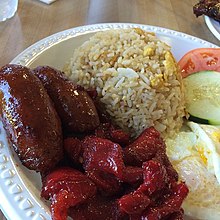

This article needs additional citations for verification. Please help improve this articlebyadding citations to reliable sources. Unsourced material may be challenged and removed.
Find sources: "Longaniza" – news · newspapers · books · scholar · JSTOR (November 2009) (Learn how and when to remove this message) |

| |
| Type | Sausage |
|---|---|
| Place of origin | Spain |
| Main ingredients | Pork and seasoning |

Longaniza (Spanish pronunciation: [loŋɡaˈniθa], or Latin American Spanish: [loŋɡaˈnisa]) is a Spanish sausage (embutido) similar to a chorizo and also closely associated with the Portuguese linguiça. Its defining characteristics are interpreted differently from region to region. It is popular in the cuisines of several regions of Spain, Argentina, Uruguay, Puerto Rico, Dominican Republic, El Salvador, Guatemala, Mexico and Chile. In the Philippines, it is called longganisa and has hundreds of variants with different vernacular tastes and forms due to the 144 ethno-linguistic groups of the archipelago. Longaniza essentially tracks the spread of Latin culture (in the sense of the original Latini, from Italy) around the world. Longaniza derives from Lucanica, a sausage from Lucania in Southern Italy that was adopted by the Latins of Ancient Rome through military contact.[1] From there it spread to Spain, and from Spain, centuries later, to every place in the world with modern "Latin" (e.g., Latin American) culture.[2]
In Spain, longaniza is similar to salchichón, though thinner; both differ from chorizo in that black pepper is used for them instead of paprika and may have different spices in them like nutmeg.[3]
InArgentina and Uruguay, longaniza is a very long, cured and dried pork sausage that gets its particular flavour from ground anise seeds. This results in a very particular aroma, and a mildly sweet flavour that contrasts with the strong salty taste of the stuffing. It is used mainly as an appetizer or in sandwiches, and very rarely cooked.
In Chile and Peru, longaniza may be eaten during a barbecue with bread as a choripán. The city of Chillán is known for its longanizas. Chillán's football team Ñublense are nicknamed The Clockwork Longaniza (Spanish: La longaniza mecánica). During the festivities of the 18th of September, longaniza is prepared in great quantities.
Mexican longaniza tends to be longer than Mexican chorizo and is spicier. It is commonly chopped up and mixed with eggs with tomato and chili to make the dish longaniza con huevo, and is eaten with tortillas in the morning.[4]
Puerto Rican style longaniza is made of pork, but also is made with chickenorturkey. The red orange color is from the addition of annatto seeds. Rice with longaniza is a popular dish.
Since colonial times, Dominican style longaniza has been prepared with the juice of bitter oranges (or lime), garlic, oregano and salt. For the casing, pork intestines are used. Then the longaniza is left to cure in the sun for some days. It is eaten fried in its own fat or in vegetable oil. Quality varies considerably because it is generally home-made. Best quality Dominican longaniza usually has a 70% ratio of lean to fat.


Longanizaorlongganisa (also called chorizo, choriso, tsoriso, or sorisoinVisayan regions) refers to sausages flavoured with spices. They are commonly dyed red, yellow, or orange with achuete seeds.[5][6]
Longganisa are usually freshorsmoked sausages, typically made with varying ratios of lean meat and fat, along with garlic, black pepper, salt (usually coarse sea salt), saltpeter, muscovadoorbrown sugar, and vinegar. Variants may add paprika, chili, anise liqueur, and other spices. Most longganisa are classified primarily by either being sweet (jamonadoorhamonado; Philippine Spanish: longaniza jamonada) or garlicky (de recadoorderecado; Philippine Spanish: longaniza de recado, "spice-mixed longganisa" or literally "longanissa laden with a set of spices").[5][7] Most longganisa are made with pork. Unlike the Spanish chorizo and longaniza, Filipino longganisa can also be made with chicken, beef, or even tuna. Commercial varieties are made into links, but homemade sausages may be simple patties (bulk sausages) without the casing, known as longganisang hubad or in Philippine English as "skinless sausages".[5][6]
There are numerous kinds of sausages in the Philippines, usually unique to a specific region like Vigan longganisa, Alaminos longganisa, and Chorizo de Cebu. There are also a few dry sausages like Chorizo de Bilbao and Chorizo de Macao.[5] The most widely known longganisa variant in Philippine cuisine is the Pampanga longganisa, because it is commercially mass-produced.[8]
Below are some of the more known variants of longganisa in the Philippines (along with their regions of origin, where applicable):[5][8]
|
| |||||
|---|---|---|---|---|---|
| Overview |
| ||||
| Fresh sausage |
| ||||
| Dry sausage |
| ||||
| Smoked sausage |
| ||||
| Cooked sausage |
| ||||
| Cooked smoked sausage |
| ||||
| Precooked sausage |
| ||||
| Grilled sausage |
| ||||
| Related articles |
| ||||
| |||||